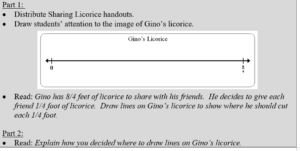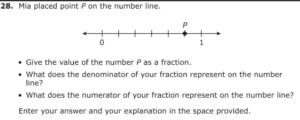Understand a fraction as a number on the number line; represent fractions on a number line diagram.
b. Represent a fraction a/b on a number line diagram by marking off a lengths 1/b from 0. Recognize that the resulting interval has size a/b and that its endpoint locates the number a/b on the number line.
[divider] [/divider] Students are able to…
- Use fraction strips to find fractional parts on a number line.
- Label intervals and points on the number lines. Intervals are unit fractions. Points on the number line represent 0 to that specific point and are made up the number of unit fraction intervals.
- Extend number lines and recognize patterns to develop understanding that fractions equal to one have the same numerator and denominator and fractions greater than one have a numerator that will be greater than the denominator
[divider] [/divider] Students are able to…because teachers:
- Provide students with fraction strips and number lines and ask students to transfer the parts from the fraction strip to the number line.
- Facilitate discussions in which students explain their reasoning as they label number lines.
- Extend the number line to numbers greater than one using the same rationale for naming points on a number line.
- Provide students with many opportunities to describe patterns they see as they label number lines.
[divider] [/divider] Questions to ask students:
- See if students can correctly represent a given fraction, for example three-fourths, on a number line by marking off lengths of one-fourth starting at 0.
- Ask students how they would justify their representation of three-fourths on a number line.
- Sample answer that indicates understanding: Student correctly describes drawing or draws a number line from 0-1 and partitions the distance into four equal parts and explains that 3 pieces of one-fourth or that distance from 0 to that point represents three-fourths on the number line.
- Sample answer that indicates an incomplete understanding or a misconception: Student partitions the number line by drawing four lines, resulting in 5 equal parts, or parts are not equal. Student’s model or explanation does not include partitioning of one whole, but instead only includes counting by fourths.
- Ask students to explain how they would represent a given fraction greater than one, for example five-fourths, on a number line.
- Sample answer that indicates understanding: By counting intervals by unit fractions, four-fourths would be located at the same place as 1 whole on the number line, and one additional fourth would show five-fourths.
[divider] [/divider] FSA Notes
Cognitive Complexity Level: 2 – Basic Application of Skills and Concepts
Achievement Level Descriptors:
2- identifies the fraction on the number line where the increments are equal to the denominator
3- represents a fraction a/b on a number line by partitioning the number line into b equal parts, and marking off a lengths of 1/b from zero; recognizes that the resulting interval has size a/b and that its endpoint locates the fraction a/b on the number line
4- represents a fraction greater than 1 on a number line
5- represents a set of fractions and fractions greater than 1 with unlike denominators on a number line by partitioning into equal parts
Assessment Limits:
[divider] [/divider] Additional Resources:
Additional in depth content knowledge
Blog Post: Modeling Fractions on a Number Line
Video: Plotting Fractions Greater than One on a Number Line
Sample Formative Assessment Task:
Resources/Tasks to Support Your Child at Home:
- Ask your child to represent 5/8 on a number line
- Ask your child to model 3 feet of rope on a number line. If every third foot you needed to tie a knot, how could you show that on your number line?
- LearnZillion Video – Fractions Greater than One a Number Line


